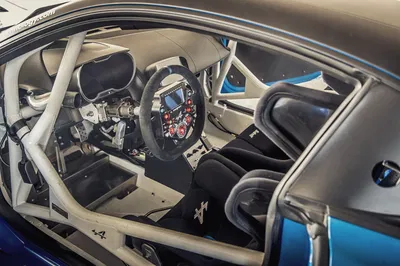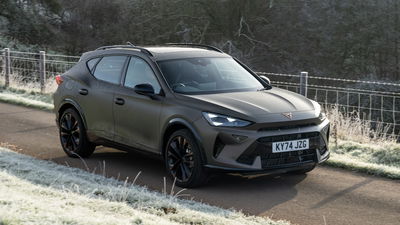Driving The Alpine A110 Cup Racing Car Required A Total Brain Recalibration

Pros
Cons
The circuit notes say to brake at the 100-metre board before Turn 6. I’m entirely convinced the mighty stoppers are capable of hauling this Alpine A110 Cup racing car to the required speed if I hit the pedal exactly then. I have no doubts whatsoever.
And yet, something triggers in my brain as I stare at the rapidly approaching tyre barrier, and my foot hits the brake pedal. I want to kick myself as I inevitably end up bleeding off when I realise I’ve stabbed the pedal far too soon.
The next lap at Southern France’s very technical Nogaro circuit, I can feel vibrations start to pass through the cabin. Is there a problem with the car? Otherwise, it feels fine, but when I’m back in the pits, I report the problem regardless. The answer isn’t one I’ve been expecting, nor one I’m terribly happy to hear.

“The tyres are getting too cold, so they’re picking up all the crap from the track surface,” I’m told. “So I’m driving too slow?” I reply. “Well, I wouldn’t necessarily say that…” the engineer trails off. Ah.
That’s the problem with proper, slick-shod racing cars - they don’t really work if you’re not driving them fast enough. It’s either on or off, there’s no in-between. Now I have some idea of where the track goes, I need to up my game and do this car some justice.
The Apline A110 Cup - devised for a one-make, pan-European racing series of the same name - is a serious piece of kit that requires a serious approach. I can certainly be leaning on those brakes - a six-piston, 335mm rear/four-piston, 333mm rear setup from Brembo - a lot more than I am.

From the outside, the car is instantly recognisable due to using all of the production A110’s bodywork, but it now sits 70mm lower, propped up by an Ohlins adjustable damper at each corner, the belly of this pint-sized beast damn near scraping along the floor.
So dramatic was the ride height drop, it necessitated the relocation of the standard car’s forged aluminium double wishbones, which were retained along with the stock hubs and uprights. The negative camber angle is also considerably more aggressive, something you notice as soon as you see the car. Yes, it’s still very much an A110. It’s just an A110 that’s spent many hours in the gym and undergone special forces training.

Internally, the 1.8-litre inline-four turbo engine is identical to the one you’ll find in the road car, with an extra 19bhp - bringing the total to 266bhp - liberated by a race exhaust and a freer-breathing air filter. That power is sent to the 265mm-wide slicks at the back via a six-speed sequential racing gearbox and a mechanical limited-slip differential.
It has, of course, been thoroughly stripped out, but as the Alpine A110 is already a light car, there’s not a lot of fat to trim. With its bigger wheels and tyres, roll cage, extinguisher system and more added in, the total weight loss amounts to 30kg.
It’s still extremely light, however, and that doesn’t just help the way it handles - there are also massive cost benefits. A lighter car can use smaller tyres and brakes, so they’re cheaper to replace. And you won’t have to change them as often. When it comes to the stoppers, the pads will last for around half the season and the discs for the whole year. It’s no wonder the closely related GT4 version is proving so popular.

Sinking back into the deep bucket seat for my second session, the six-point harness is clipped in over my HANS device and tightened close to the point of being painful. If I feel like I can still breathe, it’s not tight enough, apparently…
I study the racer’s button-festooned steering wheel, its traction control dial set - as it was last time out - to 0, and the ABS control sat at 1. Use of either is unrestricted in the A110 Cup, and many competitors do still use the ABS and its 11 different settings to some extent. It’s the same story with the traction control’s nine levels, but only in the wet - using it is fairly pointless in the dry given the 1.8’s smooth power delivery and modest mid-range torque combined with the super sticky slicks.

A press of the green starter button and the mid-mounted engine barks into life. There is a clutch pedal, used only to get the car moving. And it’s hilariously tricky to use. For the first time today, I’ve just about managed to set off without stalling.
The power steering setup is another thing carried straight over from the A110 road car, and, software-wise, it’s essentially locked to the ‘sport’ setting. The experience is very different though, since in the racer, every flick of the wheel is turning a pair of 245mm-wide slick tyres, not two skinny 205-section Michelin PS4s. There’s more meat to the front end, even if the retention of power steering means it’s not exactly a workout in the tight and tricky hairpins of Turn 4 and 5, which so far I’ve ballsed up every lap. Apart from this one.

I get the best exit from 5 I’ve yet had, feeding in the power as I emerge onto the long back straight. The modest power output means the car feels purposefully quick rather than scary fast, with much of the drama coming from the delicious whine of the racing gearbox. And the engine, which thanks to its new lungs and the Cup’s complete lack of soundproofing now fills the cabin with noise.
Every shift up from the steering wheel is a brilliantly brutal thump in the back, and the marker boards are approaching swiftly as the digital speedometer flicks past 200kmh. Those marker boards lead to my nemesis, Turn 6.

I’ve braked about as late as I dare, which takes a surprising amount of pressure on the pedal as sixth gear becomes fifth, fourth, third, and then second. There’s the slightest hint of the ABS intervening, and moments later I’m through the corner with a line I’m finally satisfied with, ready to blast through the fast right-hander that follows. The circuit notes, which are all in French, state ‘a fond!’, which Google helpfully translates as ‘thoroughly’.
"It's taken me about 13 laps in the car, but at last, I feel like I've retuned my brain to the the grip and traction of slicks"
Taking it as thoroughly as I can, I can feel the back end of the A110 Cup start to go, but such is the communicative nature of the car, I’m warned early enough that a modulation of the throttle is all it takes. No sketchy dabs of opposite lock required here and the car is straightened up ready for Turn 9, which is tighter than it looks.
It’s taken me about 13 laps in the car, but at last, I feel like I’ve just about retuned my brain to the extreme levels of grip and traction from a car on slicks. Strapped in so tightly, there’s that elusive sense of the car being an extension of the self, which never, ever happens with road cars.

It’s nimble. Incredibly well balanced. Monstrously capable. But most of all approachable - a mid-engined, rear-drive, one-make racing car immediately sounds scary and hard to handle, but that’s not the Alpine. I can see why, beyond the one-make championship itself, people are buying these things as track cars.
The start/finish straight, well, isn’t - it’s slightly curved and very short, meaning there’s precious little time to check how quick the last lap was, particularly given how small the readout is. But it felt fantastic, as though I was, at last, pushing the car, with all of those cold tyre vibrations banished. Surely, that was a decent effort?

A quick glance down at the screen in the middle of the steering wheel a few corners later, and I feel a tinge of disappointment - it’s an improvement, but one not as significant as I’d been anticipating. It’s now my last flyer, but I’ve had to go long at the end of the back straight to let another, quicker car through. Further trimming of my lap time is now unlikely to happen.
This, though, gives me one final target: if I can keep this guy in sight and not more than a corner away for the remainder of the lap, I’ll be happy. I try to be a little braver with the brakes, more analytical with the lines I’m taking, and keep my eyes much further up the road, resisting the temptation to target fixate on scary tyre walls.

It takes everything in my rather limited skill set, but I’ve done it. I’m far from on the other A110 Cup’s bumper, but he hasn’t disappeared into the distance either. This, I think, seems an acceptable effort for my first time in the car, and my first time at the track.
Hey, if I’m playing racing driver for the day, the excuses are a key part of that, right?















Comments
That is just a sexy and amazing car.
Shame we dont see the stock ones that much.
This is the only reason I hate living in America, the fact that I will never be able to own a stock version of this.